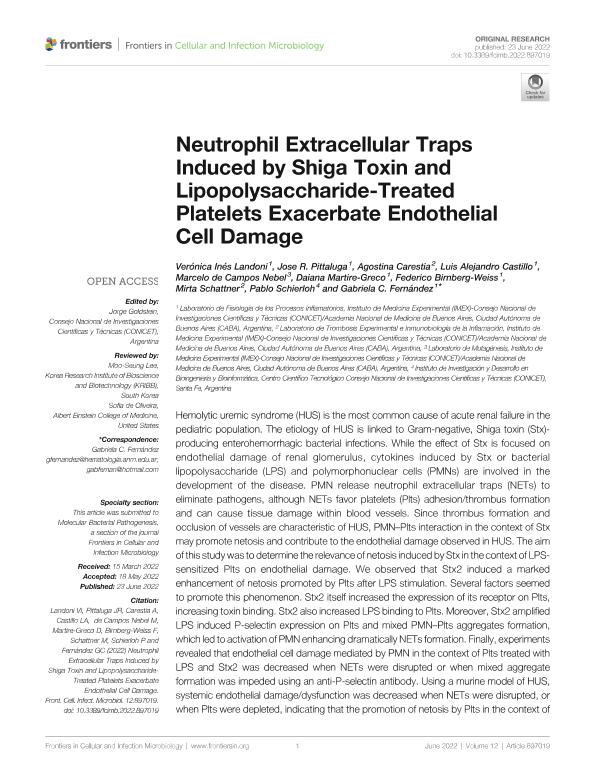Artículo
Neutrophil Extracellular Traps Induced by Shiga Toxin and Lipopolysaccharide-Treated Platelets Exacerbate Endothelial Cell Damage
Landoni, Verónica Inés ; Pittaluga Villareal, Jose Ramon
; Pittaluga Villareal, Jose Ramon ; Carestia, Agostina
; Carestia, Agostina ; Castillo Montañez, Luis Alejandro
; Castillo Montañez, Luis Alejandro ; de Campos Nebel, Ildefonso Marcelo
; de Campos Nebel, Ildefonso Marcelo ; Martire Greco, Daiana
; Martire Greco, Daiana ; Birnberg Weiss, Federico
; Birnberg Weiss, Federico ; Schattner, Mirta Ana
; Schattner, Mirta Ana ; Schierloh, Luis Pablo
; Schierloh, Luis Pablo ; Fernández, Gabriela Cristina
; Fernández, Gabriela Cristina
 ; Pittaluga Villareal, Jose Ramon
; Pittaluga Villareal, Jose Ramon ; Carestia, Agostina
; Carestia, Agostina ; Castillo Montañez, Luis Alejandro
; Castillo Montañez, Luis Alejandro ; de Campos Nebel, Ildefonso Marcelo
; de Campos Nebel, Ildefonso Marcelo ; Martire Greco, Daiana
; Martire Greco, Daiana ; Birnberg Weiss, Federico
; Birnberg Weiss, Federico ; Schattner, Mirta Ana
; Schattner, Mirta Ana ; Schierloh, Luis Pablo
; Schierloh, Luis Pablo ; Fernández, Gabriela Cristina
; Fernández, Gabriela Cristina
Fecha de publicación:
06/2022
Editorial:
Frontiers Media
Revista:
Frontiers in Cellular and Infection Microbiology
ISSN:
2235-2988
Idioma:
Inglés
Tipo de recurso:
Artículo publicado
Clasificación temática:
Resumen
Hemolytic uremic syndrome (HUS) is the most common cause of acute renal failure in the pediatric population. The etiology of HUS is linked to Gram-negative, Shiga toxin (Stx)-producing enterohemorrhagic bacterial infections. While the effect of Stx is focused on endothelial damage of renal glomerulus, cytokines induced by Stx or bacterial lipopolysaccharide (LPS) and polymorphonuclear cells (PMNs) are involved in the development of the disease. PMN release neutrophil extracellular traps (NETs) to eliminate pathogens, although NETs favor platelets (Plts) adhesion/thrombus formation and can cause tissue damage within blood vessels. Since thrombus formation and occlusion of vessels are characteristic of HUS, PMN–Plts interaction in the context of Stx may promote netosis and contribute to the endothelial damage observed in HUS. The aim of this study was to determine the relevance of netosis induced by Stx in the context of LPS-sensitized Plts on endothelial damage. We observed that Stx2 induced a marked enhancement of netosis promoted by Plts after LPS stimulation. Several factors seemed to promote this phenomenon. Stx2 itself increased the expression of its receptor on Plts, increasing toxin binding. Stx2 also increased LPS binding to Plts. Moreover, Stx2 amplified LPS induced P-selectin expression on Plts and mixed PMN–Plts aggregates formation, which led to activation of PMN enhancing dramatically NETs formation. Finally, experiments revealed that endothelial cell damage mediated by PMN in the context of Plts treated with LPS and Stx2 was decreased when NETs were disrupted or when mixed aggregate formation was impeded using an anti-P-selectin antibody. Using a murine model of HUS, systemic endothelial damage/dysfunction was decreased when NETs were disrupted, or when Plts were depleted, indicating that the promotion of netosis by Plts in the context of LPS and Stx2 plays a fundamental role in endothelial toxicity. These results provide insights for the first time into the pivotal role of Plts as enhancers of endothelial damage through NETs promotion in the context of Stx and LPS. Consequently, therapies designed to reduce either the formation of PMN–Plts aggregates or NETs formation could lessen the consequences of endothelial damage in HUS.
Palabras clave:
ENDOTHELIAL CELL DAMAGE
,
LPS
,
NETOSIS
,
PLATELETS
,
SHIGA TOXIN
Archivos asociados
Licencia
Identificadores
Colecciones
Articulos (IBB)
Articulos de INSTITUTO DE INVESTIGACION Y DESARROLLO EN BIOINGENIERIA Y BIOINFORMATICA
Articulos de INSTITUTO DE INVESTIGACION Y DESARROLLO EN BIOINGENIERIA Y BIOINFORMATICA
Articulos(IMEX)
Articulos de INST.DE MEDICINA EXPERIMENTAL
Articulos de INST.DE MEDICINA EXPERIMENTAL
Citación
Landoni, Verónica Inés; Pittaluga Villareal, Jose Ramon; Carestia, Agostina; Castillo Montañez, Luis Alejandro; de Campos Nebel, Ildefonso Marcelo; et al.; Neutrophil Extracellular Traps Induced by Shiga Toxin and Lipopolysaccharide-Treated Platelets Exacerbate Endothelial Cell Damage; Frontiers Media; Frontiers in Cellular and Infection Microbiology; 12; 6-2022; 1-16
Compartir
Altmétricas



